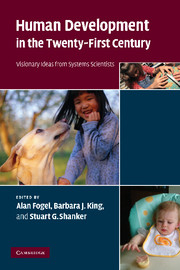Book contents
- Frontmatter
- Contents
- List of contributors
- Introduction: Why a dynamic systems approach to fostering human development?
- Part I Dynamic relationships between genetics and environments
- Part II The dynamic system of the child in the family
- Part III The dynamic system of the child in social and physical environment
- Part IV Dynamic systems approaches to mental health
- 17 A dynamic developmental model of mental health and mental illness
- 18 Dyadic microanalysis of mother–infant communication informs clinical practice
- 19 Current problems of Japanese youth: some possible pathways for alleviating these problems from the perspective of dynamic systems theory
- 20 A different way to help
- 21 Why do siblings often turn out very differently?
- 22 A dynamic systems approach to understanding family and peer relationships: implications for effective interventions with aggressive youth
- 23 Prenatal substance exposure and human development
- Part V Conclusions and outlook
- Index
- References
22 - A dynamic systems approach to understanding family and peer relationships: implications for effective interventions with aggressive youth
Published online by Cambridge University Press: 22 September 2009
- Frontmatter
- Contents
- List of contributors
- Introduction: Why a dynamic systems approach to fostering human development?
- Part I Dynamic relationships between genetics and environments
- Part II The dynamic system of the child in the family
- Part III The dynamic system of the child in social and physical environment
- Part IV Dynamic systems approaches to mental health
- 17 A dynamic developmental model of mental health and mental illness
- 18 Dyadic microanalysis of mother–infant communication informs clinical practice
- 19 Current problems of Japanese youth: some possible pathways for alleviating these problems from the perspective of dynamic systems theory
- 20 A different way to help
- 21 Why do siblings often turn out very differently?
- 22 A dynamic systems approach to understanding family and peer relationships: implications for effective interventions with aggressive youth
- 23 Prenatal substance exposure and human development
- Part V Conclusions and outlook
- Index
- References
Summary
George is fourteen years old and has begun to have serious problems at home and at school. When George was younger, he and his single mother sometimes argued but, more often, they played together, did chores cooperatively, and shared secrets with one another. Although George had no close friends during his childhood, he was still a relatively happy child. George began high school last year and things seemed to deteriorate from that point. Over the last year, George and his mother can't seem to agree on anything. Although they still turn to one another for support and affection on rare occasions, most of the time they are arguing furiously. Almost any topic of conversation seems to trigger another angry outburst. George often ends these fights by storming out of the house and his mother is left frustrated, hurt, and worried about his safety. At his new high school, George has recently been getting into physical fights with classmates. He's been suspended for his aggressive behavior and his grades have dramatically declined. Except for two other teenagers who have also been suspended, most of his peers have rejected George. As a result, George spends most of his free time “hanging out” with these two other troubled youths.
Why has George suddenly begun to act aggressively? Some psychologists would suggest that his testosterone levels have peaked now that he's reached puberty. Others would speculate that something in his genes has just started to become expressed.
- Type
- Chapter
- Information
- Human Development in the Twenty-First CenturyVisionary Ideas from Systems Scientists, pp. 216 - 224Publisher: Cambridge University PressPrint publication year: 2007
References
- 1
- Cited by



